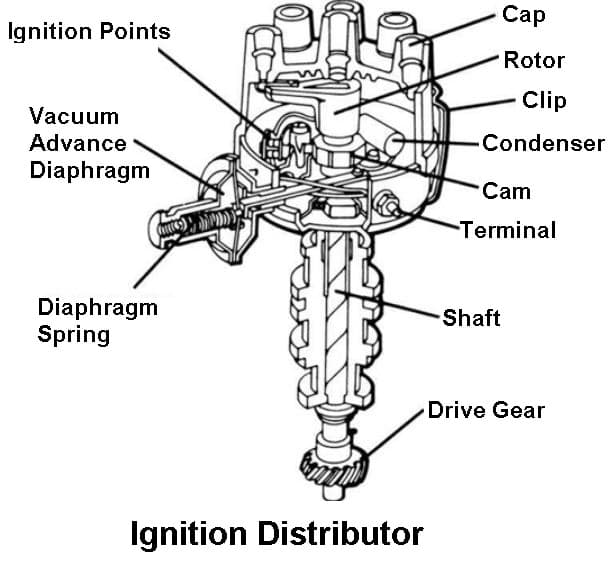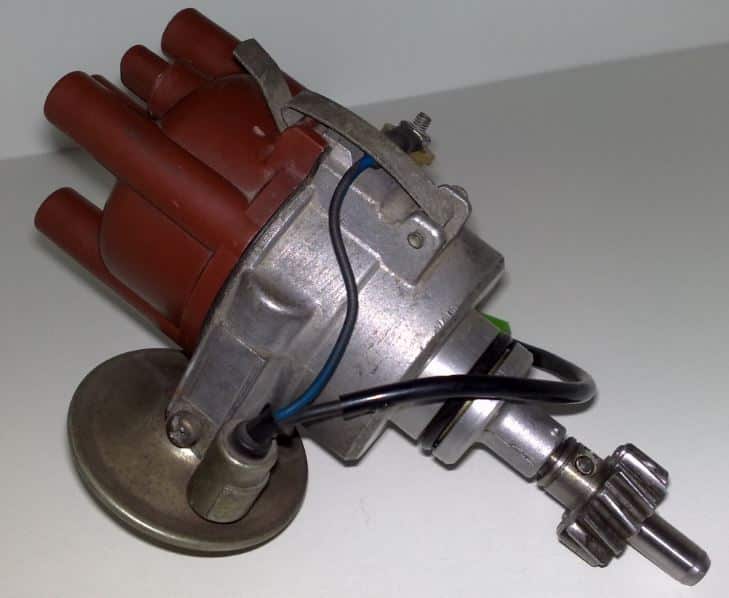In this article, you will learn how does an ignition distributor works? And its components, working, with diagram and common problems. You can also download the PDF file of this article at the end.
What is Ignition Distributor?
A distributor is defined as an enclosed rotating device that is used in I.C. engines with mechanically timed ignition.
The first reliable battery-powered ignition system was invented by a company named Delco. Then it was further developed by Charles Kettering and was considered a wonder in its time.
In the magneto system and many modern computer-controlled engines, the distributor has a mechanical or inductive breaker switch to open and close the primary circuit of the ignition coil.
The main function of the car distributor is to provide the high voltage current produced by the secondary coil to the correct spark plugs in the correct firing order and at the correct time. Now let’s see what are the parts of a distributor.
Read Also: How Distributorless Ignition System Works? Working & Components [PDF]
Parts of Distributor
Following are the parts of a distributor:
- Cam
- Capacitor
- Condenser
- Contact breaker
- Distributor cap
- Terminals
- Distributor shaft
- Drive Gear
- Rotor
- Spark advance mechanism

1. Cam
It is a part of a distributor that is attached to the distributor shaft and rotates with it. It consists of lobes to open the contact breaker point. The number of lobes in the distributor is similar to the number of cylinders.
When the cam rotates, it drives the cam, follower and the breaker points are separated causing the current to break.
2. Capacitor
It also has a capacitor to protect the contact point of the contact breaker from overheating. It improves the output of high voltage current by reversing the current flow through the primary coil.
3. Condensor
Each ignition distributor is provided with a condenser at the contact points to reduce sparks as they open into the distributor thus minimizing burns and pitting of the points. Arcing occurs due to the effect of self-induction in the coil as the points block the flow of current.
4. Contact Breaker
The contact breaker is a mechanical designed breaker point. One end of the contact breaker is movable and the other one is fixed. Its function is to create and break the primary circuit current and is connected to the breaker assembly.
As the cam’s lobe pushes the cam follower of the contact breaker, the breaker’s points that were touching each other separately and break the primary current to flow through the ignition coil’s primary winding.
5. Distributor Cap
As the name suggests, it is the cover that protects the internal parts of the distributor system and maintains contact between the internal rotor and the spark plug wires.
It has only one post for each cylinder but contact point type ignition systems have a central post that is connected to the ignition coil to draw current from it.
6. Terminals
Inside the distributor cap, there is a terminal that corresponds to each post. The plug terminals are arranged around the periphery of the cap according to the firing order so that secondary voltage is sent to the appropriate spark plug at the correct time.
7. Distributor Shaft
The distributor shaft is located in the middle of the ignition distributor. This shaft is connected to the camshaft of the engine with the help of a gear drive. It has a cam that is used to break the point of the contact breaker.
8. Drive Gear
The ratio of the distributor gear is such that it gives the distributor one full turn for every complete turn of the crankshaft and for every two complete turns of the camshaft.
This assures that the spark plugs will burn in the correct position of the piston. The drive gear is firmly attached to the distributor shaft by means of a steel roll pin.
9. Rotor
The distributor rotor is a device in a spark ignition system that provides spark from the ignition coil for proper contact inside the distributor cap. It is driven by the camshaft of the engine and is therefore synchronized with it. As the camshaft rotates, the distributor shaft also rotates. This will cause the rotor attached to the distributor shaft to rotate.
10. Spark Advance Mechanism
It is a mechanism used in spark-ignition engines to drive the spark. Its function is to burn the fuel before the piston reaches TDC. This provides the air-fuel mixture in the cylinder to burn completely and, as a result, there will be maximum pressure on the piston.
There are usually two types of spark advance mechanism in this and i.e. centrifugal advance spark mechanism and vacuum spark advance mechanism.
Read also: What are different parts car engine has?
Function of Ignition Distributor
The working of the ignition distributor is simple. When the distributor shaft began to rotate, it also rotates the cam and rotor of the distributor. While the cam rotates it pushes the cam follower that is connected to the contact breaker.

The contact points of the contact breaker suddenly open and close the primary current through the primary winding. This action produces the high voltage of current in the secondary winding.
The high voltage current is transferred to the central terminal of the current distributor. This current from the central terminal then travels through the carbon brush to the outer edges of the rotor.
Finally, as the rotor makes contact with the internal terminal of the spark plug in the distributor cap, a high voltage electrical pulse travels to the spark plug and gives a spark within the cylinder head.
In this way, the distributor generates a spark in each spark plug in the correct order and at the right time.
Distributor Problems
A running engine gives a high power to the rotor through the ignition coil that rotates inside the distributor. The rotor transmits energy through spark plug wires to the cylinders of the engine in a typically correct firing sequence.
The rotor and cap hold the distributor’s contents separate from the engine and keep the parts of the distributor clean and neat, by supporting incredibly high voltages of energy and delivering them to the proper spark plugs.
The spark plug uses a spark from the distributor to ignite the fuel mixture that keeps the engine operating. High voltage passes through the whole distributor system during vehicle operation. But if there is a problem with it, the voltage will not be supplied to the correct spark plugs to ensure the engine is running.
As soon as the distributor’s rotor and cap wear out, it will give some symptoms that will alert the driver to a service that may be needed urgently. Let’s see what symptoms can occur due to the failure of the distributor.
- Engine misfiring
- Car does not start
- Abnormal Shaking
- Excessive or unusual engine noises
1. Engine Misfiring
Engine misfiring will probably happen at times for a number of purposes. But, the safest place to check your distributor rotor and cap to see if they need to be replaced. It also ensures that the distributor rotor and cap are in their best condition.
2. Car Does Not Start
If the distributor cap is not tightened or is faulty, the engine is unable to send a spark through the entire circuit needed to move the cylinders, which drives the car. Fixing it keeps the car running.
3. Abnormal Shaking
This is the most common sign that will start with small vibration and eventually lead to shaking that can be held throughout the vehicle. This shaking may be a sign that the distributor cap and rotor are not working properly, which is interfering with the timing and firing process.
4. Excessive or Unusual Engine Noises
If the distributor rotor and cap are bad your vehicle can make some very strange noises – especially because the cylinders will try to fire but fail. You may hear a noise like tapping, clicking, or sputtering sound when the distributor rotor and cap are failing.
Wrapping It Up
As I already said above, a distributor is a rotating shaft used in spark-ignition engines. Its main function is to supply voltage or current from the ignition coil to the spark plug in the correct firing sequence and timing.
So for now, I hope that you have learned about the “Distributor Ignition System“. If you have any questions or doubts about this article, feel free to ask in the comments. If you got this article helpful, please share it with your friends.
Want free PDFs in your inbox? Then subscribe to our newsletter.
Download PDF file of this article:
Read more in our blog:
Its good and educative, please send me a copy
The PDF file has been sent to your inbox.
Send me please the PDF exploded views
The PDF file has been sent to your inbox.
These pdfs have been very help
Since I’m a mechanical student.
Thanks for reading.
This is very helpful,thanks a lot.
You’re welcome.
YES–VERY GOOD EXPLANATION
Thank you.
The pdf sir pliiiiz
I have sent you the PDF file to your inbox.
Send me PDF plz sir to mail
The PDF file has been sent to your inbox.
Sir, kindly sent me a pdf for me to study and learn.
Thank you so much and God Bless you
Thanks for reading. I have sent you the PDF file to your inbox.
Can you send me the PDF please
The PDF file has been sent to your inbox.
Kindly share some information about wheels and wheel alignment
We will definitely write on this too. Thanks for suggesting.